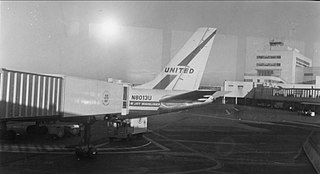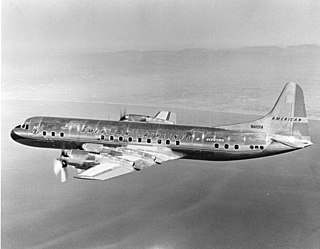
Air Florida Flight 90 was a scheduled U.S. domestic passenger flight operated by Air Florida from Washington National Airport to Fort Lauderdale–Hollywood International Airport, with an intermediate stopover at Tampa International Airport. On January 13, 1982, the Boeing 737-222 registered as N62AF crashed into the 14th Street Bridge over the Potomac River.

Capital Airlines was an airline serving the eastern, southern, southeastern, and midwestern United States. Capital's headquarters were located at Washington National Airport across the Potomac river from Washington, D.C. where crew training and aircraft overhauls were also accomplished. In the 1950s Capital was the fifth largest United States domestic carrier by passenger count after the Big Four air carriers.

On December 16, 1960, a United Airlines Douglas DC-8 bound for Idlewild Airport in New York City collided in midair with a TWA Lockheed L-1049 Super Constellation descending toward LaGuardia Airport. The Constellation crashed on Miller Field in Staten Island and the DC-8 in Park Slope, Brooklyn, killing all 128 aboard the two aircraft and six people on the ground. The accident, the world's deadliest aviation disaster at the time, remains the deadliest accident in the history of United Airlines as of 2022.

American Airlines Flight 320 was a scheduled flight between Chicago Midway International Airport and New York City's LaGuardia Airport. On February 3, 1959, the Lockheed L-188 Electra performing the flight crashed into the East River during its descent, killing 65 of the 73 people on board. Poor weather conditions at the destination meant that the crew had to descend through dense clouds and fog, but the aircraft flew lower than the pilots intended and it crashed into the icy river 4,900 feet (1,500 m) short of the runway at a speed of 140 knots. American Airlines had been flying the type of aircraft in commercial service for only about two weeks before the accident.

Northeast Airlines Flight 823 was a scheduled flight from New York City's LaGuardia Airport to Miami International Airport, Florida, which crashed shortly after takeoff on February 1, 1957. The aircraft operating the service was a Douglas DC-6 four-engined propeller airliner, registration N34954, which entered service in 1955.

American Airlines Flight 157, a Douglas DC-6, departed on November 29, 1949, from New York City bound for Mexico City with 46 passengers and crew. After one engine failed in mid-flight, a series of critical mistakes by the flight crew caused the pilot to lose control of the plane during the final approach to a routine stopover at Love Field in Dallas, Texas. The airliner slid off the runway and struck a parked airplane, a hangar, and a flight school before crashing into a business across from the airport. 26 passengers and two flight attendants died. The pilot, co-pilot, flight engineer, and 15 passengers survived.

On October 14, 2004, Pinnacle Airlines Flight 3701 crashed near Jefferson City, Missouri, while flying from Little Rock National Airport to Minneapolis–Saint Paul International Airport. Flight 3701 was a repositioning flight with no passengers aboard; both pilots were killed. Federal investigators determined the crash was due to the pilots' unprofessional behavior and disregard for training and procedures.

American Airlines Flight 383 was a nonstop flight from New York City to Cincinnati on November 8, 1965. The aircraft was a Boeing 727, with 57 passengers, and 5 crew on board. The aircraft crashed on final approach to the Cincinnati/Northern Kentucky International Airport located in Hebron, Kentucky, United States. Only three passengers and one flight attendant survived the crash.
Aircraft upset is a dangerous condition in aircraft operations in which the flight attitude or airspeed of an aircraft is outside the normal bounds of operation for which it is designed. This may result in the loss of control (LOC) of the aircraft, and sometimes the total loss of the aircraft itself. Loss of control may be due to excessive altitude for the airplane's weight, turbulent weather, pilot disorientation, or a system failure.

On March 31, 1931, a Fokker F-10 belonging to Transcontinental and Western Air crashed near Bazaar, Kansas after taking off from Kansas City Municipal Airport, Kansas City, Missouri.

On July 28, 1943 American Airlines Flight 63 was flown by a Douglas DC-3, named Flagship Ohio, routing Cleveland-Columbus-Dayton-Cincinnati-Louisville-Nashville-Memphis, that crashed on the Louisville-Nashville sector about 1.6 miles (2.6 km) west of Trammel, Kentucky. The aircraft descended from 200 feet (61 m) until it struck trees, then slid across an open field and stopped in an upright position. Of the 22 people on board, 20 died. The cause of the crash was loss of control due to severe turbulence and violent downdrafts.

American Airlines Flight 28 was a scheduled domestic passenger flight that crashed on October 23, 1942, in Chino Canyon near Palm Springs, California, United States, after being struck by a United States Army Air Forces B-34 bomber. The B-34 suffered only minor damage, and landed safely at the Army Airport of the Sixth Ferrying Command, Palm Springs.

On April 4, 1955, a United Airlines Douglas DC-6 named Mainliner Idaho crashed shortly after taking off from Long Island MacArthur Airport, in Ronkonkoma, Islip, New York, United States.

Pan Am Flight 923 was a Douglas DC-4 operating from Seattle, Washington to Juneau, Alaska, which crashed into Tamgas Mountain on Annette Island, Alaska, on October 26, 1947. All 18 passengers and crew on board were killed.

Lewis August Rodert (1906-1973) of the National Advisory Committee for Aeronautics (NACA) was awarded the 1946 Collier Trophy for the design, development, and practical application of a thermal aircraft anti-icing system. NACA icing research leader from 1936 to 1945. Lew build his own de-icing systems on a Lockheed 12A and a Curtiss C-46 creating a flying de-ice laboratory.

Ryan International Airlines Flight 590 was a cargo flight carrying mail for the United States Postal Service from Greater Buffalo International Airport (BUF) in Buffalo, New York, to Indianapolis International Airport (IND) in Indiana, with a stopover at Cleveland Hopkins International Airport (CLE) in Cleveland, Ohio. On February 17, 1991, the McDonnell Douglas DC-9-15RC operating the flight crashed on takeoff from Cleveland during icing conditions. Both pilots, the aircraft's only occupants, were killed. The National Transportation Safety Board (NTSB) determined that the causes of the crash were the flight crew failing to deice their aircraft, and the inexperience of the Federal Aviation Administration (FAA), McDonnell Douglas, and Ryan International Airlines with icing condition on DC-9-10 aircraft.














